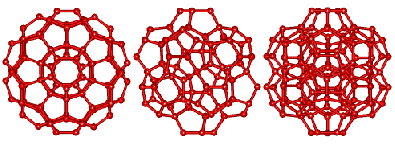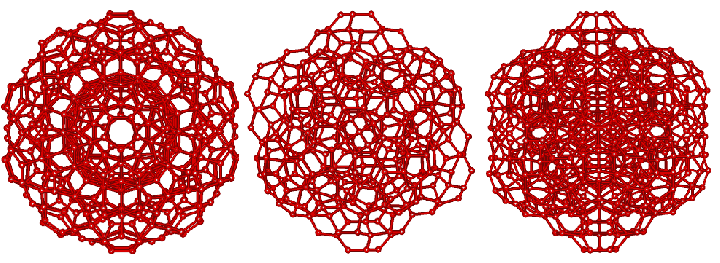
Dodecahedral clusters of water, (H2O)20, can tessellate with an only slight distortion of the preferred hydrogen bonding parameters, so long as the tessellation is not too extensive. This low-density structure may occur when a solute stabilizes the structuring by occupying the cavities and when the water concentration is low. It provides one interstitial site for every five water molecules and a mole fraction of water (xw) of 0.83. It is likely that solutes, soluble at this level, may well distort the dodecahedra. However, such a structuring shows the possibility of retaining complete hydrogen-bonding even at high concentrations of small solutes.
Tesselated dodecahedral water cluster

Shown above is an icosahedron of twelve dodecahedral structures surrounding a central dodecahedron; (H2O)130. We show only the oxygen atoms of the constituent water molecules. For interactive Figures, see Jmol.
The icosahedral model of water, (H2O)280, consists of water dodecahedra separated by two pentagonal boxes. It is also possible that a tessellated structure may arise from water dodecahedra separated by only one pentagonal box (shown below). Such a structure possesses higher energy than the icosahedral model and a lower density due to the relatively higher number of large cavities. It may, however, arise when a solute is available to stabilize the structuring by occupying the large cavities and when the water concentration is low. It provides one large interstitial site for every 25 water molecules and a mole fraction of water (xw) of 0.96. Solutes soluble at this level may well distort the dodecahedra. However, such a structuring shows the possibility of retaining complete hydrogen bonding even at moderately high concentrations of small solutes. Concentrated salts may provide water-separated ions that occupy the larger interstitial dodecahedral sites and show partial occupancy of the associated pentagonal boxes to produce water-separated ion pairs.
Tesselated dodecahedral water clusters separated by single pentagonal boxes

Shown above is an icosahedron of twelve dodecahedral structures surrounding a central dodecahedron, all separated from each other by a pentagonal box; (H2O)650. We show only the oxygen atoms of the constituent water molecules. For interactive Figures, see Jmol.
Home | Site Index | Icosahedral water cluster architecture | Icosahedral water clusters (Jmol) | LSBU | Top
This page was established in 2003 and last updated by Martin Chaplin on 19 June, 2021